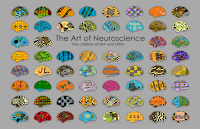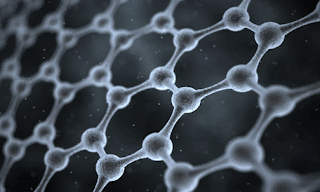Week 7: Neuroscience and Art
Week 7: Neuroscience and Art
In this week’s lecture, Professor Vesna discussed the connections and relationships between neuroscience and art and how important neuroscience has been for our culture. It’s hard to see the connection just by looking at these two fields. Neuroscience, as society tells us, is the objective study of the brain and its functions. Art is seen as subjective, creative, imaginative and often times controversial. However, when we delve a little deeper into the history of each field, we understand how the two can sometimes complement each other.
 Late in the 1960s, a visual craze called “Op Art” (Optical Art) ran rampant through the scientific and artistic fields. On the scientific side, scientists were beginning to discover how the retina processed color and contrast and how the color of someone’s iris may play a part in this process. Artists, started taking advantage of this new discovery and made art that played with people’s visual perceptions. “Artists like Richard Anuszkewitz were even characterized as “scienti c artists” in their highly methodical creation of artworks that scintil- lated the eye with its often jarring retinal effects”(Huang 1).
Late in the 1960s, a visual craze called “Op Art” (Optical Art) ran rampant through the scientific and artistic fields. On the scientific side, scientists were beginning to discover how the retina processed color and contrast and how the color of someone’s iris may play a part in this process. Artists, started taking advantage of this new discovery and made art that played with people’s visual perceptions. “Artists like Richard Anuszkewitz were even characterized as “scienti c artists” in their highly methodical creation of artworks that scintil- lated the eye with its often jarring retinal effects”(Huang 1).
The combination of neuroscience and art has mostly been seen as how the complement each other or how an artist takes a scientific discovery and implements it in his work and vice versa. However, more recently, people have been using neuroscience to study art. This technique is called neuroaesthetics. The idea that all art and creativity comes from the brain is not a revolutionary discovery, but scientists are looking towards art and understanding it though how the brain created that art (Noe).
Beason-Held, Lori. "The Art of Neuroscience II." The Neuro Bureau. N.p., 31 Mar. 2013. Web. Photo. 15 May 2016.
Dunn, Greg. "Print | Product Categories | Greg Dunn Design." Greg Dunn Design. N.p., n.d. Web. Photo. 15 May 2016.
Huang, Mengfei. "The Neuroscience of Creativity." Comic Art, Creativity and the Law (n.d.): 7-11. Stanford University. Web. 14 May 2016.
Marcos. "Toward A Brain-Based Theory of Beauty (Ishizu & Zeki, 2011)." International Network for Neuroaesthetics. N.p., 21 Aug. 2011. Web. Photo. 15 May 2016.
Noe, Alva. "Art and the Limits of Neuroscience." Opinionator Art and the Limits of Neuroscience Comments. New York Times, 4 Dec. 2011. Web. 15 May 2016.
Vesna, Victoria. Lecture. “Conscious / Memory (Part 2).” 16 Nov 2012. <http://www.youtube.com/watch?feature=player_embedded&v=Xlg5wXHWZNI>
Vesna, Victoria. “Conscious / Memory (Part 1).” Lecture. 16 Nov 2012. <http://www.youtube.com/watch?feature=player_embedded&v=DLVQIwOn7o8>




Interesting post Sean! I think you nicely explained how neuroscience and its discoveries have inspired artists to play with visual perceptions and even invent fields like neuroaesthetics. It's cool how both fields can influence each other. Well done!
ReplyDeleteI really liked your post Sean, I didn't even think to analyze the role that neuroscience took in affecting our culture. I really like the way you combine the two fields and dig deep into the roles that they play.
ReplyDeleteVery Interesting to see how we are analyzing our brains in order to understand how art is created.Maybe we can revolutionize art by knowing more about the brain
ReplyDelete